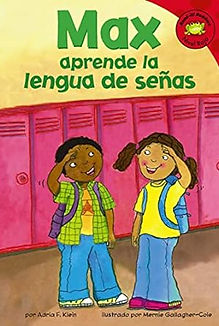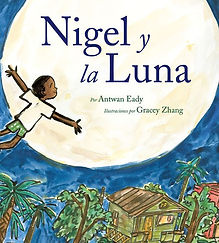
Literatura Infantil Section
Aquí les presentamos unas recomendaciones para libros de niñes que tengan buena representación de personas con discapacidades. Ojalá estas recomendaciones les ayuden a promover justicia y dignidad para personas con discapacidades en sus escuelas.
Here we present you with some recommendations for children’s books that have positive disability representation. We hope these recommendations help you promote justice and dignity for disabled folks in your schools.

Joe Arco Iris y yo by Maria Diaz Strom
Ages: 5-8
In this vibrant book, Eloise expands her understanding of colors after talking with Joe Arco Iris, her neighbor who is blind. The benefits of bringing this book into your classroom are that it serves as a positive representation of disability and encourages students to stretch their minds and question what they know. Because the story is not told from the perspective of a disabled character, teachers can invite students to engage more deeply by rewriting, retelling, or just imagining how the story might change if Joe told it.
-Kiki Grandisoriano
El Salto Largo by Francesca Cavallo
Ages: 5-8
This beautiful picture book is a biography of Jean-Baptiste Alaize, a world champion track and field athlete and Paralympic medalist who was disabled as a young boy during the civil war in his home country of Burundi. This book has meaningful representation, not just in Jean Baptiste’s story, but in the introduction by Vilissa Thompson and the illustrations by Kezna Dalz. Not only is it a wonderful book to teach about disability, but it can also serve as a conversation starter for complex topics such as civil war, colonialism, international and transracial adoption, and disability exceptionalism—yes, even for the littles!
-Kiki Grandisoriano


Max aprende la lengua de señas by Adria F. Klein
Ages: 4-7
This is a wonderful book for emergent readers. As part of the Max series by Adria F. Klein, this story shows Max choosing to learn ASL in order to better connect with his good friend Susan. A wonderful example of a hearing person adapting and learning in order to promote accessibility, the book leaves opportunity for teachers to ask students how Susan could play a bigger role in the book. Overall, this book serves as a positive representation of disability and can be used as a catalyst to get young learners to reflect on what they can do to promote accessibility.
-Kiki Grandisoriano
Max va de paseo by Adria F. Klein
Ages: 4-7
This story within the Max series shows Max and his friend Don embark on a day full of fun activities together. Don uses a wheelchair. This book can be used as a nice introduction to wheelchairs and mobility devices. Teachers can supplement it with further lessons and other stories that engage deeper with these topics. Overall, it still serves as a positive, non-harmful, representation of disability.
-Kiki Grandisoriano


Nigel y la luna by Antwan Eady, Gracey Zhang, et al.
Ages: 4-7
If you want to read something to inspire inclusiveness, choose Nigel y la Luna. Nigel has big dreams, but he feels lonely in class and can’t speak. He doesn’t feel he belongs with his peers. Instead, he feels safe talking to the moon about his dreams. This book can help students feel seen, heard and valued.
-Silvia Miranda